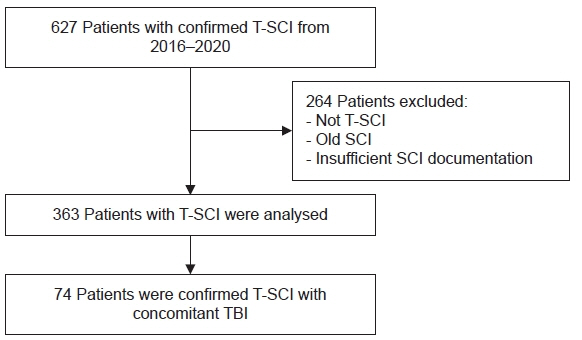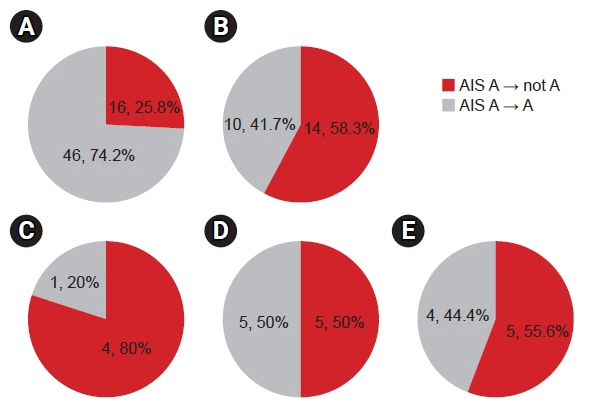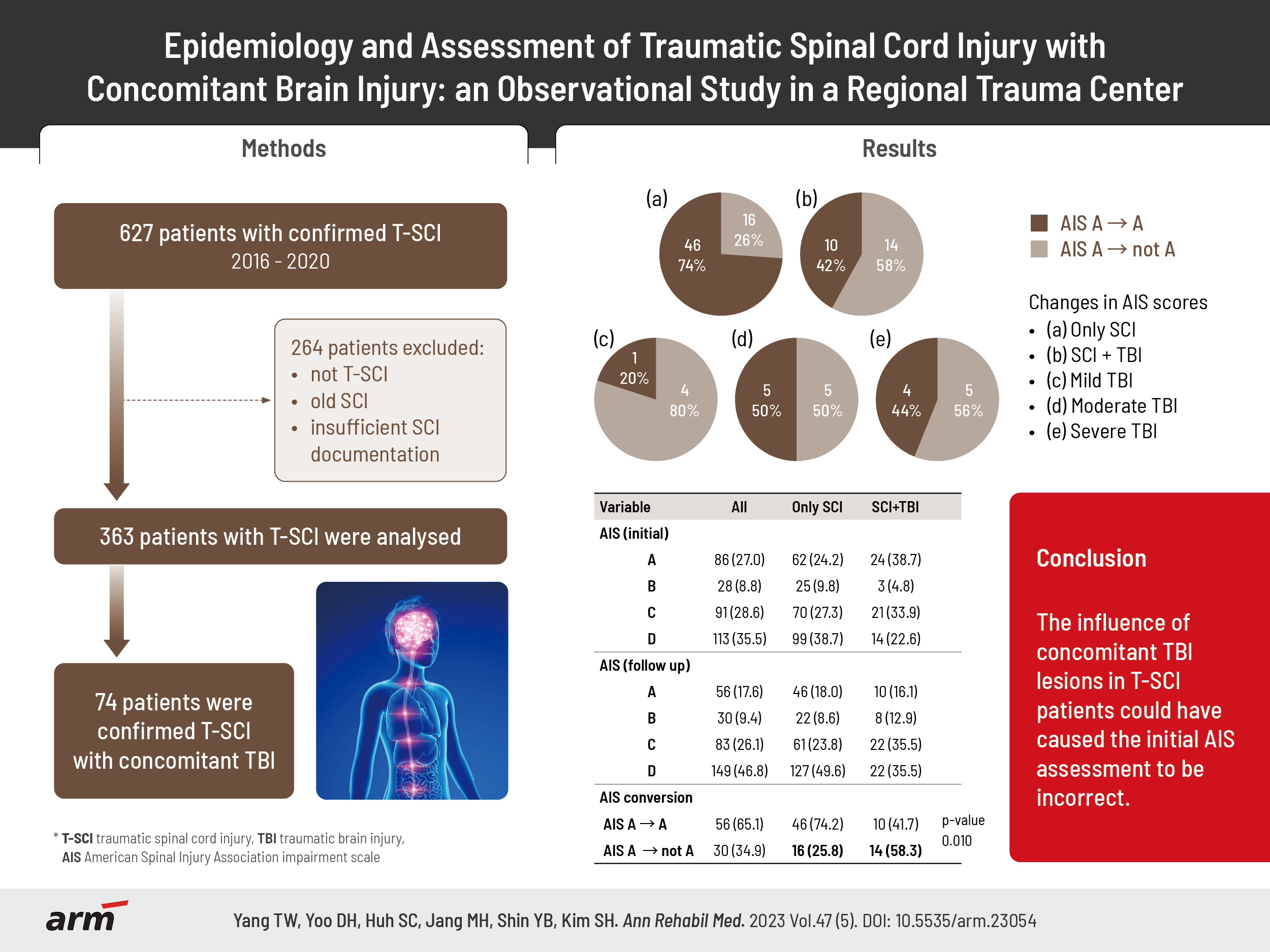Ann Rehabil Med.
2023 Oct;47(5):385-392. 10.5535/arm.23054.
Epidemiology and Assessment of Traumatic Spinal Cord Injury With Concomitant Brain Injury: An Observational Study in a Regional Trauma Center
- Affiliations
-
- 1Department of Rehabilitation Medicine, Biomedical Research Institute, Pusan National University Hospital, Busan, Korea
- 2Department of Rehabilitation Medicine, Research Institute for Convergence of Biomedical Science and Technology, Pusan National University Yangsan Hospital, Yangsan, Korea
- 3Department of Rehabilitation Medicine, Biomedical Research Institute, Pusan National University Hospital, Pusan National University School of Medicine, Busan, Korea
- KMID: 2548398
- DOI: http://doi.org/10.5535/arm.23054
Abstract
Objective
To analyze the epidemiological information of patients with traumatic spinal cord injury (SCI) and concomitant traumatic brain injury (TBI) and to suggest points to be aware of during the initial physical examination of patients with SCI.
Methods
This study was a retrospective, observational study conducted in a regional trauma center. All the records of patients diagnosed with traumatic SCI between 2016 and 2020 were reviewed. A total of 627 patients with confirmed traumatic SCI were hospitalized. A retrospective study was conducted on 363 individuals.
Results
The epidemiological data of 363 individuals were investigated. Changes in American Spinal Injury Association Impairment Scale (AIS) scores in patients with SCI were evaluated. The initial evaluation was performed on average 11 days after the injury, and a follow-up examination was performed 43 days after. Fourteen of the 24 patients identified as having AIS A and SCI with concomitant TBI in the initial evaluation showed neurologic level of injury (NLI) recovery with AIS B or more. The conversion rate in patients with SCI and concomitant TBI exceeded that reported in previous studies in individuals with SCI.
Conclusions
Physical, cognitive, and emotional impairments caused by TBI present significant challenges in rehabilitating patients with SCI. In this study, the influence of concomitant TBI lesions could have caused the initial AIS assessment to be incorrect.
Figure
Reference
-
1. Budisin B, Bradbury CC, Sharma B, Hitzig SL, Mikulis D, Craven C, et al. Traumatic brain injury in spinal cord injury: frequency and risk factors. J Head Trauma Rehabil. 2016; 31:E33–42.
Article2. Bradbury CL, Wodchis WP, Mikulis DJ, Pano EG, Hitzig SL, McGillivray CF, et al. Traumatic brain injury in patients with traumatic spinal cord injury: clinical and economic consequences. Arch Phys Med Rehabil. 2008; 89(12 Suppl):S77–84.
Article3. Garlanger KL, Beck LA, Cheville AL. Functional outcomes in patients with co-occurring traumatic brain injury and spinal cord injury from an inpatient rehabilitation facility’s perspective. J Spinal Cord Med. 2018; 41:718–30.
Article4. Macciocchi SN, Bowman B, Coker J, Apple D, Leslie D. Effect of co-morbid traumatic brain injury on functional outcome of persons with spinal cord injuries. Am J Phys Med Rehabil. 2004; 83:22–6.
Article5. Burns AS, Lee BS, Ditunno JF Jr, Tessler A. Patient selection for clinical trials: the reliability of the early spinal cord injury examination. J Neurotrauma. 2003; 20:477–82.
Article6. Hagen EM, Eide GE, Rekand T, Gilhus NE, Gronning M. Traumatic spinal cord injury and concomitant brain injury: a cohort study. Acta Neurol Scand Suppl. 2010; (190):51–7.
Article7. Tolonen A, Turkka J, Salonen O, Ahoniemi E, Alaranta H. Traumatic brain injury is under-diagnosed in patients with spinal cord injury. J Rehabil Med. 2007; 39:622–6.
Article8. Ruff RM, Iverson GL, Barth JT, Bush SS, Broshek DK; NAN Policy and Planning Committee. Recommendations for diagnosing a mild traumatic brain injury: a National Academy of Neuropsychology education paper. Arch Clin Neuropsychol. 2009; 24:3–10.
Article9. de Guise E, Alturki AY, LeBlanc J, Champoux MC, Couturier C, Lamoureux J, et al. The Montreal Cognitive Assessment in persons with traumatic brain injury. Appl Neuropsychol Adult. 2014; 21:128–35.
Article10. Macciocchi S, Seel RT, Thompson N, Byams R, Bowman B. Spinal cord injury and co-occurring traumatic brain injury: assessment and incidence. Arch Phys Med Rehabil. 2008; 89:1350–7.
Article11. de Guise E, Leblanc J, Champoux MC, Couturier C, Alturki AY, Lamoureux J, et al. The mini-mental state examination and the Montreal Cognitive Assessment after traumatic brain injury: an early predictive study. Brain Inj. 2013; 27:1428–34.
Article12. Sun H, Luo C, Chen X, Tao L. Assessment of cognitive dysfunction in traumatic brain injury patients: a review. Forensic Sci Res. 2017; 2:174–9.
Article13. Miotto EC, Cinalli FZ, Serrao VT, Benute GG, Lucia MC, Scaff M. Cognitive deficits in patients with mild to moderate traumatic brain injury. Arq Neuropsiquiatr. 2010; 68:862–8.
Article14. Biering-Sørensen F, Charlifue S, Chen Y, New PW, Noonan V, Post MWM, et al. International Spinal Cord Injury Core Data Set (version 3.0)-including standardization of reporting. Spinal Cord. 2023; 61:65–8.15. Singh A, Tetreault L, Kalsi-Ryan S, Nouri A, Fehlings MG. Global prevalence and incidence of traumatic spinal cord injury. Clin Epidemiol. 2014; 6:309–31.16. Lee BS, Kim O, Ham D. Epidemiological changes in traumatic spinal cord injuries for the last 30 years (1990-2019) in South Korea. Spinal Cord. 2022; 60:612–7.
Article17. Yang NP, Deng CY, Lee YH, Lin CH, Kao CH, Chou P. The incidence and characterisation of hospitalised acute spinal trauma in Taiwan--a population-based study. Injury. 2008; 39:443–50.
Article18. Chacko V, Joseph B, Mohanty SP, Jacob T. Management of spinal cord injury in a general hospital in rural India. Paraplegia. 1986; 24:330–5.
Article19. Ning GZ, Wu Q, Li YL, Feng SQ. Epidemiology of traumatic spinal cord injury in Asia: a systematic review. J Spinal Cord Med. 2012; 35:229–39.
Article20. National Spinal Cord Injury Statistical Center (NSCISC). The 2021 annual statistical report complete public version for the Spinal Cord Injury Model Systems. University of Alabama at Birmingham;2022. p. 1–161.21. Holly LT, Kelly DF, Counelis GJ, Blinman T, McArthur DL, Cryer HG. Cervical spine trauma associated with moderate and severe head injury: incidence, risk factors, and injury characteristics. J Neurosurg. 2002; 96(3 Suppl):285–91.
Article22. Barbetta DC, Smanioto TR, Poletto MF, Ferreira R, Lopes A, Casaro FM, et al. Spinal cord injury epidemiological profile in the Sarah Network of Rehabilitation Hospitals-a Brazilian population sample. Spinal Cord Ser Cases. 2018; 4:32.
Article23. International Transport Forum. Road safety annual report 2020. International Transport Forum;2020. p. 1–64.24. Kim HS, Lim KB, Kim J, Kang J, Lee H, Lee SW, et al. Epidemiology of spinal cord injury: changes to its cause amid aging population, a single center study. Ann Rehabil Med. 2021; 45:7–15.
Article25. Harper A, Wilkinson I. Falls in older adults: causes, assessment and management. Medicine. 2021; 49:32–7.
Article26. Rhee JM, Shamji MF, Erwin WM, Bransford RJ, Yoon ST, Smith JS, et al. Nonoperative management of cervical myelopathy: a systematic review. Spine (Phila Pa 1976). 2013; 38(22 Suppl 1):S55–67.27. Chamberlain JD, Deriaz O, Hund-Georgiadis M, Meier S, Scheel-Sailer A, Schubert M, et al. Epidemiology and contemporary risk profile of traumatic spinal cord injury in Switzerland. Inj Epidemiol. 2015; 2:28.
Article28. Knútsdóttir S, Thórisdóttir H, Sigvaldason K, Jónsson H Jr, Björnsson A, Ingvarsson P. Epidemiology of traumatic spinal cord injuries in Iceland from 1975 to 2009. Spinal Cord. 2012; 50:123–6.
Article29. Kirshblum S, Snider B, Eren F, Guest J. Characterizing natural recovery after traumatic spinal cord injury. J Neurotrauma. 2021; 38:1267–84.
Article30. Khorasanizadeh M, Yousefifard M, Eskian M, Lu Y, Chalangari M, Harrop JS, et al. Neurological recovery following traumatic spinal cord injury: a systematic review and meta-analysis. J Neurosurg Spine. 2019; 30:683–99.
Article31. Spiess MR, Müller RM, Rupp R, Schuld C; EM-SCI Study Group, van Hedel HJ. Conversion in ASIA impairment scale during the first year after traumatic spinal cord injury. J Neurotrauma. 2009; 26:2027–36.
Article32. Ely EW, Truman B, Shintani A, Thomason JW, Wheeler AP, Gordon S, et al. Monitoring sedation status over time in ICU patients: reliability and validity of the Richmond Agitation-Sedation Scale (RASS). JAMA. 2003; 289:2983–91.
Article33. Armstrong AJ, Clark JM, Ho DT, Payne CJ, Nolan S, Goodes LM, et al. Achieving assessor accuracy on the International Standards for Neurological Classification of Spinal Cord Injury. Spinal Cord. 2017; 55:994–1001.
Article
- Full Text Links
- Actions
-
Cited
- CITED
-
- Close
- Share
- Similar articles
-
- Effects of Resuscitative Endovascular Balloon Occlusion of the Aorta in Neurotrauma: Three Cases
- Paraplegia Following Spinal Cord Contusion from an Indirect Gunshot Injury
- Delayed Post-Traumatic Spinal Cord Infarction with Quadriplegia: A Case Report
- Failure of initial neurologic assessment for SCIWORA with brain injury in 22-month-old patient
- Animal Models of Traumatic Brain Injury




